US physicists say they have found “the missing link” for a practical quantum internet and, as such, taken a big step forward in the development of

cosmosmagazine.com
Google announced Wednesday it designed a machine that would take only 200 seconds to
solve a
problem that the world's fastest
computer would need 10,000 years to compute. ...
Quantum computers have been touted as a way to
solve problems that the Earth currently does not have enough computational power to tackle.
All that said, will these new computers be powerful enough to do simulated virus vaccine testing with more accuracy than test trials do now? If the answer is yes then perhaps these computers can also unscramble genomes.
So are there any new thoughts on faster than light quantum communications that many said could never happen?
The entangled state is instantaneous, but it is not possible to send information that way. The sender has no way to know what the current state is at his end. And he has no way to change the state in order to form a message. If he tries to do that, the entanglement would be broken.
The Chinese did not send any information to their satellite. They only verified that the instantaneous entanglement was much faster than light. The figure they quoted would ordinarily be infinitely fast but in practice was limited by instrumentation accuracy.
The experiment is interesting because is shows that entanglement can be used for encryption, but no information transmission is faster than light.
.
You would have laughed at von braun when he wrote in his thesis that it should be possible to shoot to the moon...……..
Quantum entanglement breakthrough could boost encryption, secure communications
Using quantum entanglement, a team of researchers has developed a new way to communicate via particles of light.
A team of researchers has published details of a new way to reliably create particles that are well-suited to use in quantum communications, which could lead to the unhackable communication protocols that have long been pitched as one of the most useful applications of the technology.
The scientists generated entangled photons, a method that applies one of the most intriguing properties of quantum physics. Entanglement is a phenomenon that occurs when two quantum particles become inextricably linked, which means that the way one behaves immediately affects the other, regardless of the distance between them.
Using quantum entanglement, a team of researchers has developed a new way to communicate via particles of light.

www.zdnet.com
You are the most dense and ignorant fool I have ever come across. Are you going to spend your entire life saying you can't or are you going to start doing what others say can't be done
Photon entanglement, in itself, is not new. In fact, the technology is already used for secure communication over thousands of kilometres, for example for satellite-to-ground or satellite-to-satellite communications. Until now, however, photons were generated in a specific wavelength – between 700 and 1,550 nanometres – which means that the light produced is close to the brightness of the sun.
Sunlight peaks around 500 nanometres, explains Matteo Clerici, senior lecturer at the University of Glasgow, who led the research; as a result, during the daytime, photon detectors struggle to differentiate the photons generated as part of a given experiment from the sun's light.
"If you have a single entangled photon, combined with hundreds of photons coming from the sun at a really close wavelength, coming towards a detector, you cannot distinguish between them," explains Clerici. Needless to say, the mixup can pose some problems for satellite communication.
Of course, you could start generating photons at wavelengths as far removed from the brightness of the sun as you possibly can, but then other challenges come into play. In some wavelengths, for example, which may be less bright, photons can instead be absorbed by certain types of atmospheric gases.
What the research team at the University of Glasgow managed to do, was to find a "transparency window" in the atmosphere, where there aren't many absorbing gases, nor is the sunlight overwhelming. That window is further into the infrared spectrum, at two micrometres wavelength.
Generating photons at two micrometres had never been demonstrated before. A major challenge for the researchers was to get their hands on the appropriate technology to conduct their experiment. "You need detectors that are able to see single photons at two micrometres, and we had to develop the right technology for these measurements," says Clerici. "And on the other side, you also need a specific piece of technology to generate the photons."
In partnership with technology manufacturer Covesion and the National Institute of Communications and Technology (NICT) in Tokyo, Clerici and his team engineered a nonlinear crystal that was suitable for operating at two micrometers. Photons are generated when short pulses of light from a laser source pass through the crystal.
SEE: This cloud service lets you use quantum and classical computing together to solve big problems
In theory, the entangled photons generated at the new wavelength should be able to travel as far as the photons generated through existing methods, and used for satellite communication. But the new experiment is still in its early stages, and Clerici said that the team hasn't yet identified how much information the new technology can communicate, or how quickly.
"There are various different ways to address daylight communication," says Clerici, "but our point is that at two micrometres, even though the technology isn't as developed as for other wavelengths, we may have an advantage, so it is worth exploring." For the team, therefore, work has only begun.
Security 

